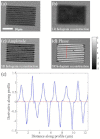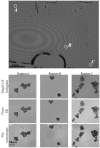Lensfree on-chip microscopy over a wide field-of-view using pixel super-resolution
- PMID: 20588977
- PMCID: PMC2898729
- DOI: 10.1364/OE.18.011181
Lensfree on-chip microscopy over a wide field-of-view using pixel super-resolution
Abstract
We demonstrate lensfree holographic microscopy on a chip to achieve approximately 0.6 microm spatial resolution corresponding to a numerical aperture of approximately 0.5 over a large field-of-view of approximately 24 mm2. By using partially coherent illumination from a large aperture (approximately 50 microm), we acquire lower resolution lensfree in-line holograms of the objects with unit fringe magnification. For each lensfree hologram, the pixel size at the sensor chip limits the spatial resolution of the reconstructed image. To circumvent this limitation, we implement a sub-pixel shifting based super-resolution algorithm to effectively recover much higher resolution digital holograms of the objects, permitting sub-micron spatial resolution to be achieved across the entire sensor chip active area, which is also equivalent to the imaging field-of-view (24 mm2) due to unit magnification. We demonstrate the success of this pixel super-resolution approach by imaging patterned transparent substrates, blood smear samples, as well as Caenoharbditis Elegans.
Figures







References
Publication types
MeSH terms
Grants and funding
LinkOut - more resources
Full Text Sources
Other Literature Sources

